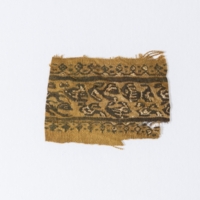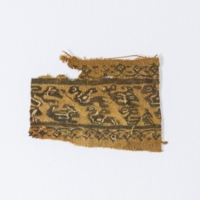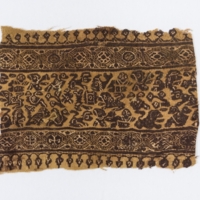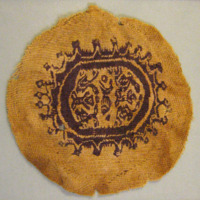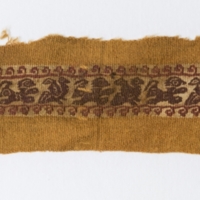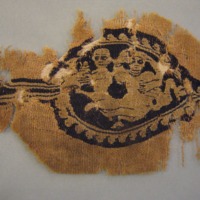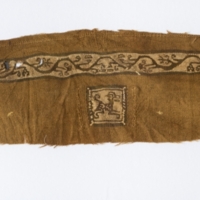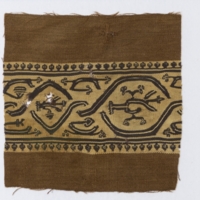Animal and Vegetal Motifs
Textile fragments featuring plants and animals are not uncommon and several of the fragments from the Arthur M. Sackler Foundation donation feature these motifs. Although it is difficult to determine what specific plants or animals these highly stylized textiles feature, they can be placed in general categories that may help explain their purpose.
In general, animals depicted in late antique/ Byzantine/ early Islamic textiles range from the mundane to the mythical. In the textile fragments donated from the Arthur M. Sackler Foundation, the animals are highly stylized and generally depict fish, various land mammals, and waterfowl. Waterfowl are depicted with a semicircular body, a curved neck and head, and a raised wing. Examples or waterfowl can be seen in Figures 1, 2, 3, 4, and 5. Fish are depicted with a round head, body and tail, as shown in Figures 1, 2, 3, and 4. Land mammals, including hares, deer-like creatures, and large cats vary greatly. Figures 3 and 5 likely feature large cats, which can be distinguished by their feline tails and manes.
Textile fragments that feature animals arranged in a procession like Figures 1, 2, and 5 likely came from a tunic. They would have been part of a decorative band on either the sleeve or the belt of the tunic and would have served as protective symbols and symbols of good luck. The origin of more elaborate fragments like Figure 3 is more difficult to determine, as fragments like this could have come from either clothing or furnishings. Figure 3 features a variety of different animals and may have been intended to depict a Nilotic scene, as the Nile and the many creatures that live in it were popular motifs in various forms of art from this period. Figure 3 also features a small cross with four triangular feet, one pair of which is notably larger than the other. This cross appears in a knot pattern that borders the animals, a pattern that was used as a protective symbol.
Figures 1 and 2 are stylistically very similar and likely came from the same textile.
Figure 4 is part of a donation from Mark and Janeth Hogue Sponenburgh. It was most likely a decorative roundel on a tunic.
Figure 6 also comes from a gift from Mark and Janeth Hogue Sponenburgh. It features mythical creatures with the torso and head of a person and the lower body of an animal, perhaps a horse or lion. Despite being depicted relatively naturalistically, what these figures are intended to be specifically is difficult to determine.
Vegetal motifs are also a common symbol of protection and good luck, especially when they accompany animal motifs as in Figure 7. This textile fragment likely came from a decorative band on a tunic, most likely around the waist. In instances when vegetal motifs accompany dancers, they likely represent grape vines as a reference to Bacchus, the Roman god of wine. In instances where vegetal motifs are not accompanied by either animals or dancers, they likely serve as a symbol of fertility, as in Figure 8.
REFERENCES
Friedman, Florence D. Beyond the Pharoahs: Egypt and the Copts in the 2nd and 7th Centuries A.D. Providence, Rhode Island: Rhode Island School of Design Museum of Art, 1989.
Haas, Christopher. Alexandria in Late Antiquity: Topography and Social Conflict. Baltimore and London: The John Jopkins University Press, 1997.
Late Egyptian and Coptic Art: An Introduction to the Collections in the Brooklyn Museum. New York: The John B. Watkins Compant, 1943.
Maguire, Eunice Dauterman. Weavings From Roman, Byzantine and Islamic Egypt: The Rich Life and the Dance. University of Illinois at Urbana-Champaign: Krannert Art Museum + Kinkead Pavilion, 1999.
Noever, Peter. Fragile Remnants: Egyptian Textiles of Late Antiquity and Early Islam. Translated by Abigail Ryan-Prohaska. Los Angeles: Schindler House, 2005.
Thomas, Thelma K. Designing Identity: The Power of Textiles in Late Antiquity. Princeton and Oxford: Princeton University Press, 2016.
